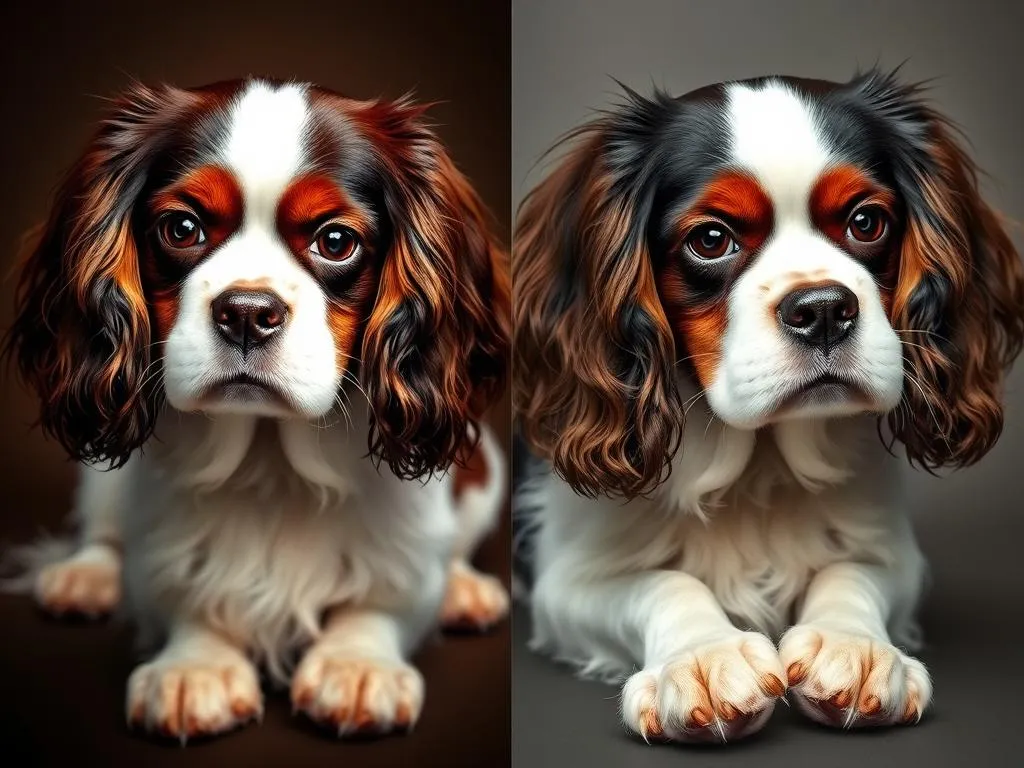
Understanding the differences and similarities between the Cavalier King Charles Spaniel and the King Charles Spaniel is crucial for potential dog owners. Choosing the right breed can significantly impact your lifestyle, family dynamics, and overall happiness. Both breeds share a rich history and charming personalities, but they also have distinct traits that set them apart. Let’s delve into their historical backgrounds, physical characteristics, temperaments, health considerations, lifestyle needs, and costs of ownership.
Historical Background
Origins of the King Charles Spaniel
The King Charles Spaniel has its roots in England, dating back to the 16th century. This breed was favored by the nobility, particularly during the reign of King Charles II, who was known for his love of small spaniels. The breed was often depicted in various forms of art, showcasing its royal connection. Early King Charles Spaniels were bred primarily as companions and were characterized by their gentle demeanor and affectionate nature.
Historically, these dogs were smaller than the modern counterparts and had a distinctive flat face and large, round eyes. Their popularity was so profound that they became synonymous with the aristocracy. However, by the 19th century, changes in breeding practices began to alter their appearance and health.
Origins of the Cavalier King Charles Spaniel
The Cavalier King Charles Spaniel emerged in the 1920s as a result of a desire to recreate the original type of spaniel that was favored by King Charles II. Breeders sought to combine the charm of the older King Charles Spaniel with more modern breeding techniques that focused on health and functionality. The Cavalier was officially recognized by the American Kennel Club (AKC) in 1995, and it quickly gained popularity due to its friendly nature and adaptability.
The breeding goals for Cavaliers emphasized a healthier body structure and a more balanced temperament, which contributed to their growing appeal as family pets. Unlike the King Charles Spaniel, which often suffered from various health issues related to its breeding, the Cavalier King Charles Spaniel was bred with a focus on both aesthetics and well-being.
Comparison of Historical Context
While both breeds share a common ancestry, their evolution diverged significantly over time. The King Charles Spaniel became increasingly bred for its physical appearance, often leading to health complications due to selective breeding practices. In contrast, the Cavalier King Charles Spaniel was developed with a more holistic approach, aiming to preserve the breed’s spirit while ensuring better health outcomes.
Royal patronage played a pivotal role in shaping the characteristics of both breeds. The King Charles Spaniel was a staple in royal households, while the Cavalier reflects a modern interpretation of the royal companion dog, with a focus on temperament and companionship.
Physical Characteristics
Size and Weight
When comparing the sizes of the two breeds, the Cavalier King Charles Spaniel is generally slightly larger than the King Charles Spaniel. Cavaliers typically weigh between 13 to 18 pounds and stand about 12 to 13 inches tall at the shoulder, while King Charles Spaniels usually weigh between 8 to 14 pounds, with a height range of 9 to 11 inches.
Coat and Color
Both breeds possess beautiful, silky coats, but there are differences in their grooming needs. Cavalier King Charles Spaniels come in several color combinations, including Blenheim (chestnut and white), tricolor (black, white, and tan), ruby (solid red), and black and tan. Their coats require regular brushing to prevent matting and reduce shedding.
In contrast, the King Charles Spaniel typically features a similar color palette, but their coat may be slightly shorter and denser. Grooming is also essential for this breed to maintain coat health and minimize shedding. Owners of both breeds should be prepared for regular grooming sessions to keep their dogs looking their best.
Distinctive Features
Distinctive physical traits set the two breeds apart. The Cavalier King Charles Spaniel has a more elongated snout and a slightly more athletic build, giving it a more balanced appearance. Its ears are long and feathered, contributing to its overall elegance. On the other hand, the King Charles Spaniel has a flatter face, which is characteristic of its historical breeding, and its eyes are often more prominent, contributing to a more “pushed-in” look.
Temperament and Behavior
General Temperament
Both breeds are known for their friendly and affectionate temperaments. However, the Cavalier King Charles Spaniel is often described as more outgoing and playful. They thrive on companionship and are known to be particularly good with children and other pets. Their lively nature makes them an excellent choice for families looking for an active and loving dog.
In contrast, the King Charles Spaniel tends to be slightly more reserved. While still affectionate, they may take a bit longer to warm up to new people and situations. This breed is also known for its calm demeanor, making it a good fit for quieter households or those who prefer a more laid-back dog.
Sociability and Interactions
Both breeds excel in social situations, but their approaches vary. The Cavalier King Charles Spaniel is generally more sociable and enjoys engaging with new people and pets. They are often described as “people pleasers,” making them easy to train and socialize.
The King Charles Spaniel is also friendly but may be a little more cautious around strangers. They can form strong bonds with their families and often exhibit loyalty and affection to those they know well. Both breeds adapt well to various social settings, but the Cavalier may adjust more quickly to new environments.
Training and Intelligence
When it comes to training, both breeds are intelligent and eager to learn. The Cavalier King Charles Spaniel is particularly known for its willingness to please, making training sessions more enjoyable for both the dog and the owner. Positive reinforcement techniques work exceptionally well with this breed, as they respond favorably to praise and rewards.
The King Charles Spaniel, while intelligent, may require a bit more patience during training. Their slightly more independent nature can lead to stubbornness, so consistency and gentle guidance are essential. Both breeds benefit from early socialization and obedience training to ensure they grow into well-mannered adults.
Health Considerations
Common Health Issues
Both the Cavalier King Charles Spaniel and the King Charles Spaniel can be prone to specific health issues, largely due to their breeding history. The Cavalier is known for conditions like mitral valve disease, hip dysplasia, and eye disorders such as cataracts. Regular vet check-ups and early detection of health problems can help manage these conditions effectively.
The King Charles Spaniel may also face health challenges, including respiratory issues due to their flat faces, as well as patellar luxation and ear infections. Understanding these potential health concerns is crucial for prospective owners to provide appropriate care.
Lifespan Comparison
The average lifespan for both breeds is similar, typically ranging from 12 to 15 years. However, health issues can affect longevity. The Cavalier King Charles Spaniel, with its focus on health-conscious breeding, may enjoy a slightly longer and healthier life compared to the King Charles Spaniel, which can experience more severe health complications.
Preventative Care and Health Management
Routine veterinary care is essential for both breeds. Regular check-ups, vaccinations, and dental care will help maintain their health and catch potential problems early. Preventative measures, including a balanced diet and regular exercise, are crucial in ensuring both breeds lead healthy lives.
Lifestyle and Care Requirements
Exercise Needs
Both breeds require regular exercise to maintain their physical and mental well-being. The Cavalier King Charles Spaniel typically has higher energy levels and enjoys engaging in play and outdoor activities. A daily walk, along with playtime, will help keep them happy and healthy.
The King Charles Spaniel is somewhat less energetic but still benefits from regular exercise. A couple of short walks and play sessions each day will suffice for this breed. Both dogs enjoy the company of their owners during exercise, making it a great opportunity for bonding.
Dietary Considerations
Dietary needs vary somewhat between the two breeds. The Cavalier King Charles Spaniel requires a high-quality diet rich in proteins and healthy fats to support its energy levels. Owners should monitor their Cavalier’s weight, as they can be prone to obesity if overfed.
The King Charles Spaniel, while also needing a balanced diet, may be more prone to weight gain due to its more sedentary tendencies. Portion control and healthy snacks are important for both breeds to maintain a healthy weight.
Living Environment
Both breeds are adaptable and can thrive in various living environments. The Cavalier King Charles Spaniel is well-suited for apartments or homes with limited space, as long as they receive enough exercise and mental stimulation.
The King Charles Spaniel also adapts well to apartment living but prefers a quieter environment. They can be more sensitive to noise, so a calm household is ideal. Both breeds are affectionate and enjoy being close to their families, making them excellent companions for various living situations.
Cost of Ownership
Initial Purchase Price
The initial purchase price for both breeds can vary significantly based on factors such as pedigree, breeder reputation, and geographic location. Generally, Cavalier King Charles Spaniels tend to be more expensive, often ranging from $1,800 to $3,500. In contrast, the King Charles Spaniel may be somewhat less costly, typically between $1,000 to $2,500.
Ongoing Expenses
Ongoing costs for both breeds include food, grooming, veterinary care, and pet insurance. Monthly expenses can average between $100 and $200, depending on the quality of food and frequency of grooming. Regular vet visits, vaccinations, and potential health issues must be factored into long-term financial planning for either breed.
Conclusion
In summary, the Cavalier King Charles Spaniel and the King Charles Spaniel both offer unique and rewarding experiences for dog owners. While they share a common lineage and many characteristics, their differences in temperament, health, and care requirements can significantly influence your decision.
When choosing between these breeds, consider your lifestyle, living situation, and family dynamics. Both breeds can bring immense joy and companionship, but understanding their unique traits will help you make an informed decision that aligns with your needs. Whether you opt for the playful and outgoing Cavalier or the calm and affectionate King Charles, both breeds promise to be loving companions for years to come.









